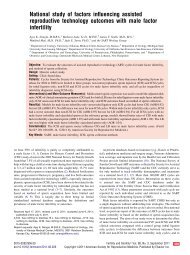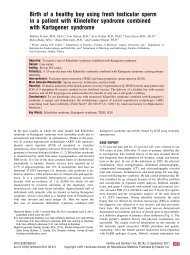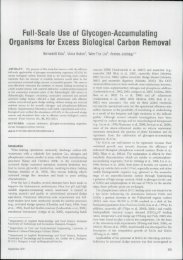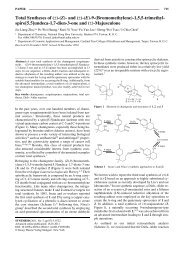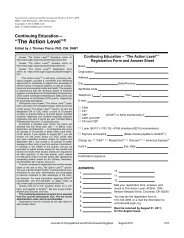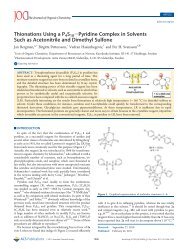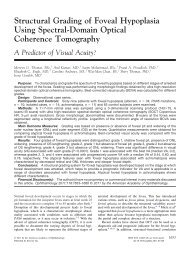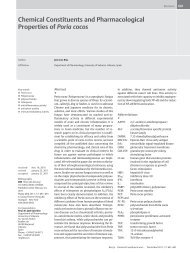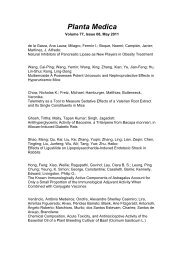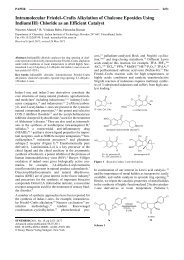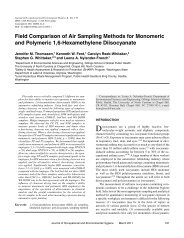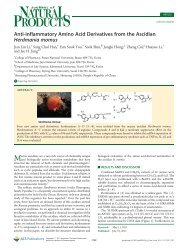Simple Synthesis of Some 2-Substituted Melatonin Derivatives
Simple Synthesis of Some 2-Substituted Melatonin Derivatives
Simple Synthesis of Some 2-Substituted Melatonin Derivatives
You also want an ePaper? Increase the reach of your titles
YUMPU automatically turns print PDFs into web optimized ePapers that Google loves.
PAPER 273<br />
<strong>Simple</strong> <strong>Synthesis</strong> <strong>of</strong> <strong>Some</strong> 2-<strong>Substituted</strong> <strong>Melatonin</strong> <strong>Derivatives</strong><br />
<strong>Synthesis</strong> Natalia <strong>of</strong> 2-<strong>Substituted</strong> <strong>Melatonin</strong> <strong>Derivatives</strong> A. Lozinskaya,* Sergey E. Sosonyuk, Maria S. Volkova, Michael Yu. Seliverstov, Marina V. Proskurnina,<br />
Sergey E. Bachurin, Nikolay S. Zefirov<br />
Chemistry Department, Moscow State University, Leninskie gory, 1, 3, GSP-1, Moscow 119991, Russian Federation<br />
Fax +7(495)9391620; E-mail: natalylozinskaya@gmail.com<br />
Received 17 July 2010; revised 10 September 2010<br />
Abstract: A simple strategy for the synthesis <strong>of</strong> some 2-substituted<br />
melatonin derivatives using p-anisidine as starting material is reported.<br />
The key step is a chemoselective reduction <strong>of</strong> a cyano group<br />
in the presence <strong>of</strong> an appropriate acid anhydride by hydrogenation<br />
over Adams’ catalyst or with sodium borohydride in the presence <strong>of</strong><br />
catalytic amounts <strong>of</strong> anhydrous nickel(II) chloride. The 2-substituted<br />
melatonin derivatives were obtained in six or seven steps from<br />
inexpensive p-anisidine in 9–13% overall yield.<br />
Key words: indoles, melatonin derivatives, reductions, medicinal<br />
chemistry<br />
<strong>Melatonin</strong> (N-acetyl-5-methoxytryptamine) is the principle<br />
neurohormone secreted by the pineal gland. 1 Its medicinal<br />
use is restricted due to low selectivity and too<br />
broad spectrum <strong>of</strong> action. The search for melatonin analogues<br />
with greater selectivity is very important. Two subtypes<br />
(Mel1a and Mel1b) <strong>of</strong> human melatonin receptors<br />
are known. A recent molecular modeling study2a and additional<br />
experimental data2b have shown that melatonin<br />
derivatives with bulky substituents at position 2 exhibited<br />
a greater affinity for Mel1b melatonin receptors than for<br />
Mel1a receptors. In the case <strong>of</strong> halogens, 2-bromomelatonin3<br />
is more selective and exhibits a greater affinity<br />
for Mel1b receptors than 2-iodomelatonin, a useful ligand<br />
for both melatonin receptor subtypes. 2-Chloromelatonin,<br />
proposed to have a much greater selectivity, has been previously<br />
mentioned as a low-yield product <strong>of</strong> direct chlorination<br />
<strong>of</strong> melatonin. 4 In this study, we report a simple<br />
strategy for the synthesis <strong>of</strong> 2-chloromelatonin and 2-oxo-<br />
2,3-dihydromelatonin, and derivatives, in good overall<br />
yield.<br />
Cyano compound 2 was prepared as a mixture <strong>of</strong> stereoisomers<br />
via Knoevenagel condensation <strong>of</strong> 5-methoxyisatin<br />
(5-methoxyindoline-2,3-dione, 1) with cyanoacetic<br />
acid using the method <strong>of</strong> Pietra5 (Scheme 1). It has been<br />
previously reported that hydrogenation <strong>of</strong> compound 2 in<br />
the presence <strong>of</strong> palladium on carbon led to a selective reduction<br />
<strong>of</strong> the carbon–carbon double bond. 6 We have<br />
found that the use <strong>of</strong> the less expensive reduction system<br />
zinc dust–aqueous hydrochloric acid resulted in a high<br />
yield <strong>of</strong> compound 3. The key compound for further synthesis,<br />
(5-methoxy-2-oxoindolin-3-yl)acetonitrile (4),<br />
SYNTHESIS 2011, No. 2, pp 0273–0276xx.xx.2010<br />
Advanced online publication: 14.12.2010<br />
DOI: 10.1055/s-0030-1258361; Art ID: Z18110SS<br />
© Georg Thieme Verlag Stuttgart · New York<br />
MeO<br />
MeO<br />
MeO<br />
Scheme 1<br />
was prepared via decarboxylation <strong>of</strong> acid 3 in 2-ethoxyethanol<br />
(Scheme 1).<br />
Cyano compound 4 was hydrogenated using Adams’ catalyst<br />
(PtO2) in a mixture <strong>of</strong> acetic acid and acetic anhydride<br />
at room temperature and atmospheric pressure. 2-<br />
Oxo-2,3-dihydromelatonin (5) was obtained in high yield<br />
(Scheme 2).<br />
MeO<br />
Scheme 2<br />
4<br />
1<br />
2<br />
3<br />
N<br />
H<br />
NC<br />
N<br />
H<br />
NC<br />
N<br />
H<br />
N<br />
H<br />
O<br />
O<br />
COOH<br />
O<br />
COOH<br />
EtO<br />
O<br />
O<br />
NCCH2COOH 1)<br />
1,4-dioxane<br />
Et3N,<br />
CN<br />
r.t.<br />
2) aq HCl<br />
53%<br />
aq HCl Zn,<br />
r.t. EtOAc,<br />
85%<br />
MeO<br />
COOH<br />
(2-Chloro-5-methoxy-1H-indol-3-yl)acetonitrile (6) was<br />
prepared by refluxing (5-methoxy-2-oxoindolin-3-yl)acetonitrile<br />
(4) in phosphorus oxychloride (Scheme 3).<br />
Further hydrogenation <strong>of</strong> compound 6 in the presence <strong>of</strong><br />
Adams’ catalyst led to dechlorination <strong>of</strong> the indole, and no<br />
2-chloromelatonin was obtained. Selective nitrile reduction<br />
was achieved using sodium borohydride in methanol<br />
in the presence <strong>of</strong> catalytic amounts <strong>of</strong> anhydrous nickel(II)<br />
chloride. Addition <strong>of</strong> acetic anhydride to the reduc-<br />
OH<br />
reflux, 2.5 h<br />
66%<br />
MeO<br />
MeO<br />
Ac2O, AcOH, H2, PtO2<br />
r.t., 1 atm, 4 h, 80%<br />
2<br />
3<br />
4<br />
NC<br />
NC<br />
N<br />
H<br />
N<br />
H<br />
N<br />
H<br />
O<br />
COOH<br />
O<br />
CN<br />
O<br />
NHAc<br />
MeO<br />
O<br />
5<br />
N<br />
H
274 N. A. Lozinskaya et al. PAPER<br />
MeO<br />
Scheme 3<br />
MeO<br />
4<br />
= Me, Et R<br />
= O, Cl X<br />
Scheme 4<br />
N<br />
H<br />
N<br />
H<br />
CN<br />
3, reflux<br />
POCl<br />
O<br />
CN<br />
X<br />
h 4<br />
82%<br />
NaBH4<br />
2O (RCO)<br />
(cat.) NiCl2<br />
r.t. MeOH,<br />
MeO<br />
MeO<br />
tion mixture allowed 2-chloromelatonin to be obtained, in<br />
good yield (Scheme 4; Table 1, entry 5).<br />
2-Oxo-2,3-dihydromelatonin (5) was also obtained by the<br />
reduction <strong>of</strong> nitrile 4 with sodium borohydride in methanol<br />
in the presence <strong>of</strong> acetic anhydride and nickel(II) chloride,<br />
in lower yield than the Adams’ catalyst supported<br />
hydrogenation (Table 1, cf. entries 1 and 2).<br />
Propionic anhydride, instead <strong>of</strong> acetic anhydride, can also<br />
be used for the synthesis <strong>of</strong> melatonin analogues (Table 1,<br />
entries 3 and 6).<br />
In conclusion, a simple strategy for the synthesis <strong>of</strong> 2chloromelatonin,<br />
2-oxo-2,3-dihydromelatonin, and derivatives<br />
was devised. The binding affinity <strong>of</strong> all synthesized<br />
compounds to melatonin receptors is under investigation.<br />
Melting points were determined on an Electrothermal 9100 melting<br />
point apparatus and are uncorrected. 1 H NMR spectra were recorded<br />
at 400.13 MHz on a Bruker Avance 400 spectrometer. The 1 H<br />
chemical shifts (d) are reported in ppm using TMS as standard internal<br />
reference (d = 0). Coupling constants (J) are given in Hz. IR<br />
spectra were recorded in vaseline oil with a Specord UR-20 spectrometer.<br />
The reaction processes and the purity <strong>of</strong> the products were<br />
monitored by thin-layer chromatography (TLC) on Silufol UV-254<br />
plates with EtOAc as eluent. Liquid chromatography was carried<br />
out with Merck silica gel (40/60). Mass spectra (MS) were recorded<br />
with a Finnigan MAT INCOSSO spectrometer (electron impact, 70<br />
eV).<br />
<strong>Synthesis</strong> 2011, No. 2, 273–276 © Thieme Stuttgart · New York<br />
6<br />
N<br />
H<br />
CN<br />
Cl<br />
NHCOR<br />
Table 1 Yields and Conditions for the Reduction <strong>of</strong> Nitriles 4 and 6<br />
Entry R X Method a Yield (%)<br />
1 Me OH A 80<br />
2 Me OH B 37<br />
3 Et OH B 68<br />
4 Me Cl A –<br />
5 Me Cl B 55<br />
6 Et Cl B 12<br />
a Method A: H2, Ac 2O, AcOH, PtO 2, r.t., 4 h; Method B: NaBH 4,<br />
(RCO) 2O, NiCl 2 (cat.), MeOH, r.t., 4 d.<br />
N<br />
H<br />
X<br />
2-(Hydroxyimino)-N-(4-methoxyphenyl)acetamide<br />
In a 4-L glass flask, a soln <strong>of</strong> chloral hydrate (145.6 g, 0.88 mol) and<br />
Na 2SO 4 (500.0 g, 3.5 mol) in H 2O (2 L) was heated at 65 °C with<br />
stirring, then a warm soln <strong>of</strong> p-anisidine (98.4 g, 0.8 mol) in 36% aq<br />
HCl (68 mL) and H 2O (480 mL) was added. After the temperature<br />
reached 75 °C, a soln <strong>of</strong> hydroxylamine hydrochloride (88.8 g, 1.27<br />
mol) in H 2O (400 mL) was added. The heating source was turned<br />
<strong>of</strong>f, and the solution was cooled to r.t. with stirring. The light-brown<br />
precipitate was collected by filtration; yield: 97.5 g (63%); mp 184–<br />
185 °C (Lit. 7 184–185 °C). The product was used without further<br />
purification.<br />
5-Methoxyisatin (1)<br />
A mixture <strong>of</strong> H2O (17 mL) and concd H2SO4 (88 mL) was heated to<br />
75 °C with stirring in a 250-mL three-neck flask. 2-(Hydroxyimino)-N-(4-methoxyphenyl)acetamide<br />
(25 g, 0.13 mol) was added in<br />
portions <strong>of</strong> ca. 1–2 g for 1.5–2 h and the temperature was kept in the<br />
range 65–80 °C during the reaction. After the addition, the still<br />
warm (ca. 50–60 °C) mixture was poured into ice water. The dark<br />
brown precipitate was collected, washed with H2O, dried and recrystallized<br />
(AcOH) to give a brown-red solid; yield: 20.25 g<br />
(88%); mp 201–205 °C (AcOH) (Lit. 6a 204–204.5 °C).<br />
1H NMR (400.13 MHz, DMSO-d6): d = 3.74 (s, 3 H, OCH3), 6.83–<br />
6.85 (d, J = 8.6 Hz, 1 H), 7.06 (s, 1 H), 7.16–7.18 (dd, J =2.5, 7.6<br />
Hz, 1 H), 10.86 (s, 1 H, NH).<br />
Cyano(5-methoxy-2-oxoindolin-3-ylidene)acetic Acid (2)<br />
A mixture <strong>of</strong> 5-methoxyisatin (1; 10.3 g, 0.06 mol), 1,4-dioxane (30<br />
mL), cyanoacetic acid (4.94 g, 0.06 mol) and Et3N (9.68 mL, 0.072<br />
mol) was placed into a 100-mL flat-bottom flask. The mixture was<br />
vigorously stirred (4 h) at 25 °C. After the reaction had ended (monitored<br />
by TLC), concd HCl (30 mL) was added. The mixture was<br />
kept at 25 °C for 3 d; the obtained precipitate was collected by filtration<br />
and dried, giving a dark product as a mixture <strong>of</strong> stereoisomers<br />
(3:2, according to 1H NMR spectroscopy); yield: 7.8 g (53%);<br />
mp 193–210 °C (Lit. 5 194–195 °C).<br />
IR (vaseline oil): 2315–2340 (NH), 2230 (CN), 1730 (COOH),<br />
1640 cm –1 (CONHR).<br />
1H NMR (400.13 MHz, DMSO-d6): d = 3.69 (s, 3 H, major product),<br />
3.74 (s, 3 H, minor product), 6.76–6.80 (d, J = 8.6 Hz, 2 H),<br />
7.00–7.09 (m, 1 H), 7.36–7.43 (m, 2 H), 7.69 (d, J = 2.5 Hz, 1 H),<br />
10.83 (s, 1 H).<br />
Anal. Calcd for C12H8N2O4: C, 59.02; H, 3.30; N, 11.47. Found: C,<br />
59.23; H, 3.47; N, 11.35.<br />
Cyano(5-methoxy-2-oxoindolin-3-yl)acetic Acid (3)<br />
To a soln <strong>of</strong> cyano(5-methoxy-2-oxoindolin-3-ylidene)acetic acid<br />
(2; 2.537 g, 0.01 mol) in EtOAc (42.4 mL) was added 3 N aq HCl<br />
(10.2 mL, 0.03 mol) and zinc powder (1.2 g, 0.02 mol). The reaction<br />
was carried out with vigorous stirring at r.t. Completion <strong>of</strong> the reaction<br />
was indicated by a color change from purple to bright yellow.<br />
It is worth noting that sometimes the color change could be a reversible<br />
process (i.e., the yellow solution became purple again after several<br />
minutes); in that case, more zinc and aq HCl should be added.<br />
Afterwards, the organic layer was separated, dried (Na2SO4) and<br />
concentrated. The title compound was isolated as a mixture <strong>of</strong> two<br />
diastereomers (3:2, according to 1H NMR spectroscopy); yield:<br />
2.09 g (85%); tan solid; mp 185 °C (Lit. 6b 184–185 °C).<br />
IR (vaseline oil): 2315–2340 (NH), 1950 (br, CN), 1730 (COOH),<br />
1650 cm –1 (br, CONHR).<br />
1H NMR (400.13 MHz, DMSO-d6): d = 3.69 (s, 3 H, OCH3, minor<br />
isomer), 3.71 (s, 3 H, OCH3, major isomer), 4.08 (d, J = 3.2 Hz, 1<br />
H, CH, minor isomer), 4.16 (d, J = 4.0 Hz, 1 H, CH, major isomer),<br />
4.82 (d, J = 3.2 Hz, 1 H, CH, minor isomer), 4.95 (d, J = 4.0 Hz, 1
PAPER <strong>Synthesis</strong> <strong>of</strong> 2-<strong>Substituted</strong> <strong>Melatonin</strong> <strong>Derivatives</strong> 275<br />
H, CH, major isomer), 6.80 (m, 5 H, ArH), 7.07 (s, 1 H, ArH), 10.42<br />
(s, 1 H, NH, major isomer), 10.51 (s, 1 H, NH, minor isomer).<br />
(5-Methoxy-2-oxoindolin-3-yl)acetonitrile (4)<br />
A soln <strong>of</strong> cyano(5-methoxy-2-oxoindolin-3-yl)acetic acid (3; 2 g,<br />
0.008 mol) in 2-ethoxyethanol (10 mL) was heated under reflux for<br />
2.5 h with stirring. Afterwards, the mixture was concentrated under<br />
reduced pressure and the dark oil was dissolved in warm EtOAc.<br />
The solution was passed through a silica gel column, which gave a<br />
light-orange solid after evaporation <strong>of</strong> the EtOAc; yield: 1.09 g<br />
(66%); mp 155–160 °C (Lit. 6b 180–181 °C).<br />
IR (vaseline oil): 2315–2340 (NH), 2280 (CN), 1700 (br, CONHR),<br />
1620 cm –1 (C=C).<br />
1H NMR (400.13 MHz, CDCl3): d =2.77 (dd, J = 17.0, 9.1 Hz, 1 H,<br />
CH2), 3.10 (dd, J = 17.0, 4.8 Hz, 1 H, CH2), 3.70 (dd, J = 8.6, 4.8<br />
Hz, 1 H, CH), 3.81 (s, 3 H, OCH3), 6.89 (dd, J = 8.6, 8.6 Hz, 1 H,<br />
ArH), 7.02 (s, 1 H, ArH), 7.20 (d, J = 8.6 Hz, 1 H, ArH), 8.45 (s, 1<br />
H, NH).<br />
MS (EI, 70 eV): m/z (%) = 202 (25), 175 (2), 162 (100), 147 (14),<br />
131 (13), 119 (18), 104 (11), 91 (9), 77 (14).<br />
N-[2-(5-Methoxy-2-oxoindolin-3-yl)ethyl]acetamide (2-Oxo-<br />
2,3-dihydromelatonin, 5)<br />
Method A (Scheme 2)<br />
(5-Methoxy-2-oxoindolin-3-yl)acetonitrile (4; 1 g, 0.005 mol) was<br />
hydrogenated over Adams’ catalyst (50 mg, 0.22 mmol) in the presence<br />
<strong>of</strong> Ac 2O (0.5 mL) in glacial AcOH (15 mL) at atmospheric<br />
pressure and r.t. Hydrogenation was continued until 0.222 L <strong>of</strong> H 2<br />
was absorbed (nearly 4 h). The catalyst was filtered <strong>of</strong>f and the solution<br />
was concentrated under reduced pressure. The residue was<br />
dissolved in CH 2Cl 2 (30 mL), which was then washed with dilute aq<br />
NaHCO 3 (10 mL) and concentrated; yield: 1 g (80%); mp 138–<br />
146 °C (dec).<br />
Method B (Table 1, Entry 2)<br />
(5-Methoxy-2-oxoindolin-3-yl)acetonitrile (4; 0.436 g, 2.2 mmol),<br />
MeOH (10 mL), Ac2O (0.63 mL, 6.7 mmol) and anhyd NiCl2 (0.018<br />
g, 0.14 mmol) were placed into a 30-mL flask. NaBH4 (0.18 g, 4.7<br />
mmol) was added at 0 °C. The mixture was stirred at 25 °C for 4 d,<br />
and NaBH4 (0.04 g) was added once per day. When the reaction was<br />
complete, the MeOH was evaporated under reduced pressure and<br />
the residue was washed with aq K2CO3. The product was extracted<br />
with EtOAc (2 × 10 mL), and the organic layer was dried (Na2SO4) and concentrated under reduced pressure; yield: 0.2 g (37%).<br />
1H NMR (400.13 MHz, CDCl3): d = 1.95 (s, 3 H, CH3), 1.98–2.09<br />
(m, 1 H), 2.17–2.24 (m, 1 H), 3.41–3.51 (m, 3 H), 3.77 (s, 3 H,<br />
OCH3), 6.58 (br s, 1 H, NH), 6.72–6.75 (dd, J = 10.6, 6.4 Hz, 1 H),<br />
6.79–6.81 (d, J = 8.4 Hz, 1 H), 6.90 (s, 1 H), 9.04 (s, 1 H, NH).<br />
13C NMR (100.6 MHz, CDCl3): d = 23.04, 29.94, 36.96, 44.75,<br />
55.76, 110.38, 111.09, 112.75, 130.59, 135.01, 155.76, 170.82,<br />
180.47.<br />
MS (EI, 70 eV): m/z (%) = 248 (35), 205 (7) [M + – CH3CO], 189<br />
(45), 176 (100) [M + – CH3CONHCH2], 163 (17), 117 (23), 83 (38).<br />
Anal. Calcd for C13H16N2O3: C, 62.89; H, 6.50; N, 11.28. Found: C,<br />
62.70; H, 6.31; N, 11.12.<br />
N-[2-(5-Methoxy-2-oxoindolin-3-yl)ethyl]propanamide (Table<br />
1, Entry 3)<br />
(5-Methoxy-2-oxoindolin-3-yl)acetonitrile (4; 0.211 g, 0.001 mol),<br />
MeOH (10 mL), propionic anhydride (0.3 mL, 0.0023 mol) and anhyd<br />
NiCl 2 (0.027 g, 0.21 mmol) were placed into a 30-mL flask.<br />
NaBH 4 (0.2 g, 5.3 mmol) was added at 0 °C. The mixture was<br />
stirred at 25 °C for 4 d, and NaBH 4 (0.1 g) was added twice per day.<br />
When the reaction was complete, the MeOH was evaporated under<br />
reduced pressure and the residue was washed with aq K2CO3. The<br />
product was extracted with EtOAc (2 × 10 mL), and the organic layer<br />
was dried (Na2SO4) and concentrated under reduced pressure;<br />
yield: 0.177 g (68%).<br />
1H NMR (400.13 MHz, CDCl3): d = 1.26 (t, 3 H), 2.04–2.08 (m, 3<br />
H), 2.18–2.28 (m, 2 H), 3.20–3.27 (m, 1 H), 3.73 (s, 3 H), 6.68 (m,<br />
2 H), 6.93 (s, 1 H).<br />
(2-Chloro-5-methoxy-1H-indol-3-yl)acetonitrile (6)<br />
A mixture <strong>of</strong> (5-methoxy-2-oxoindolin-3-yl)acetonitrile (4; 0.1 g,<br />
0.5 mmol) and pure POCl3 (5 mL) was heated under reflux for 4 h<br />
with stirring. After the reaction was complete, the excess POCl3 was<br />
evaporated under reduced pressure. The residue was washed with<br />
aq K2CO3 and extracted with CH2Cl2 (2 × 10 mL). The organic layer<br />
was dried (Na2SO4) and concentrated to give a beige solid; yield:<br />
0.09 g (82%); mp 135–136 °C.<br />
IR (film): 2650–2800 (NH), 2270 (CN), 1700, 1600 cm –1 (C=C).<br />
1H NMR (400.13 MHz, CDCl3): d = 3.77 (s, 2 H), 3.88 (s, 3 H), 6.89<br />
(dd, J = 8.8, 2.3 Hz, 1 H), 7.02 (s, 1 H), 7.19 (d, J =8.9 Hz, 1 H),<br />
8.45 (s, 1 H, NH).<br />
13C NMR (100.6 MHz, CDCl3): d = 12.96, 22.69, 29.70, 55.85,<br />
99.72, 111.83, 113.22, 115.00, 126.64, 129.19, 154.95.<br />
MS (EI, 70 eV): m/z (%) = 220 (100) [M + ], 205 (75), 194 (7), 185<br />
(35), 177 (85), 170 (7), 162 (10), 148 (35), 142 (32), 134 (7), 120<br />
(15).<br />
N-[2-(2-Chloro-5-methoxy-1H-indol-3-yl)ethyl]acetamide (2-<br />
Chloromelatonin; Table 1, Entry 5)<br />
(2-Chloro-5-methoxy-1H-indol-3-yl)acetonitrile (6; 0.150 g, 0.68<br />
mmol), MeOH (3.58 mL), Ac2O (0.13 mL, 1.4 mmol) and anhyd<br />
NiCl2 (0.018 g, 0.138 mmol) were placed into a 30-mL flask.<br />
NaBH4 (0.18 g, 4.7 mmol) was added at 0 °C. The mixture was<br />
stirred at 25 °C for 4 d, and NaBH4 (0.15 g) was added once per day.<br />
When the reaction was complete, the MeOH was evaporated under<br />
reduced pressure and the residue was washed with aq K2CO3. The<br />
product was extracted with EtOAc (2 × 5 mL), and the organic layer<br />
was dried (Na2SO4) and concentrated under reduced pressure; yield:<br />
0.1 g (55%); mp 120–130 °C (dec) (Lit. 4 124 °C).<br />
1H NMR (400.13 MHz, CDCl3): d = 1.93 (s, 3 H, CH3), 2.92 (t,<br />
J = 6.6 Hz, 2 H), 3.53 (dd, J = 6.3, 6.4 Hz, 2 H), 3.84 (s, 3 H,<br />
OCH3), 5.60 (s, 1 H), 6.84 (dd, J = 2.3, 8.8 Hz, 1 H), 6.96 (d, J =2.3<br />
Hz, 1 H), 7.18 (d, J = 8.8 Hz, 1 H), 8.50 (s, 1 H, NH).<br />
MS (EI, 70 eV): m/z (%) = 266 (20), 207 (100), 194 (80), 185 (27),<br />
177 (33), 170 (7), 162 (10), 151 (33), 142 (17), 114 (50), 89 (20).<br />
Anal. Calcd for C13H15ClN2O2: C, 58.54; H, 5.67; N, 10.50. Found:<br />
C, 58.30; H, 5.84; N, 9.35.<br />
N-[2-(2-Chloro-5-methoxy-1H-indol-3-yl)ethyl]propanamide<br />
(Table 1, Entry 6)<br />
(2-Chloro-5-methoxy-1H-indol-3-yl)acetonitrile (6; 0.109 g, 0.495<br />
mmol), MeOH (10 mL), propionic anhydride (0.14 mL, 1.1 mmol)<br />
and anhyd NiCl2 (0.016 g, 0.12 mmol) were placed into a 30-mL<br />
flask. NaBH4 (0.18 g, 4.7 mmol) was added at 0 °C. The mixture<br />
was stirred at 25 °C for 4 d, and NaBH4 (0.1 g) was added once per<br />
day. When the reaction was complete, the MeOH was evaporated<br />
under reduced pressure and the residue was washed with aq K2CO3. The product was extracted with EtOAc (2 × 5 mL), and the organic<br />
layer was dried (Na2SO4) and concentrated under reduced pressure;<br />
yield: 0.017 g (12%).<br />
1H NMR (400.13 MHz, CDCl3): d = 1.27 (t, 3 H), 2.12–2.18 (m, 2<br />
H), 3.04 (m, 2 H), 3.68–3.73 (m, 2 H), 3.84 (s, 3 H), 6.83 (d, J =7.1<br />
Hz, 1 H), 6.99 (d, J = 7.1 Hz, 1 H), 7.15 (s, 1 H).<br />
<strong>Synthesis</strong> 2011, No. 2, 273–276 © Thieme Stuttgart · New York
276 N. A. Lozinskaya et al. PAPER<br />
References<br />
(1) Dubocovich, M. L.; Rivera-Bermudez, M. A.; Gerdin, M. J.;<br />
Masana, M. I. Front. Biosci. 2003, 8, 1093.<br />
(2) (a) Voronkov, A. E.; Ivanov, A. A.; Baskin, I. I.; Palyulin, V.<br />
A.; Zefirov, N. S. Dokl. Biochem. Biophys. 2005, 403, 284.<br />
(b) Lira-Rocha, A.; Espejo-González, O.; Naranjo-<br />
Rodríguez, E. B. Eur. J. Med. Chem. 2002, 37, 945.<br />
<strong>Synthesis</strong> 2011, No. 2, 273–276 © Thieme Stuttgart · New York<br />
(3) Doss, S. H.; Mohareb, R. M.; Elmegeed, G. A.; Luca, N. A.<br />
Pharmazie 2003, 58, 607.<br />
(4) Bidylo, T. I.; Yurovskaya, M. A. Chem. Heterocycl. Compd.<br />
2005, 41, 1339.<br />
(5) Pietra, S. Farmaco 1958, 13, 75.<br />
(6) (a) Pietra, S. Farmaco 1957, 12, 946. (b) Daisley, R. W.;<br />
Walker, J. Eur. J. Med. Chem. 1979, 14, 47.<br />
(7) Bachman, G. B.; Picha, G. M. J. Am. Chem. Soc. 1946, 68,<br />
1599.



